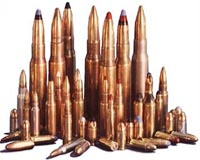| . |  |
. |
Washington (UPI) May 8, 2009 There are three basic stages in the ammunition supply chain to provide the U.S. armed forces with the ordnance that is necessary to successfully conduct their military operations. The first of these is the production or acquisition of basic materials, mostly energetics -- propellants and explosives -- but also metal parts, detonators, fuses and other ordnance. There are many different types of propellants, such as single-, double- and triple-base gun propellants and a number of rocket propellants, as well as explosives, each of which requires its own production line. The second step is the loading, assembling and packaging of munitions, which takes place at virtually all of the ammunition plants and is known as the LAP process. Even for small-caliber ammunition, the LAP process can be extremely sophisticated, and it requires the integration of the many parts that make up a single piece of ammunition, cannon round or shell. The final step is either storage of the munitions or delivery to the war fighter. Although shrinking in size and aging overall, the ammunition industrial base has managed so far to meet the U.S. armed forces' newfound demands. In 2001, only the Lake City Army Ammunition Plant, located in Independence, Mo., produced small-caliber ammunition. Fortunately, the plant and its contracted operator, Alliant Techsystems, also known as ATK, were able to respond to the challenge of the global war on terror, due in part to investments made by ATK in the facility. The most notable improvement was acquiring and moving to the Lake City plant the only surviving line for the production of the links to create belts for 5.56mm, 7.62mm and .50-caliber machine guns. After the terrorist attacks on the United States of Sept. 11, 2001, as demand for small-caliber ammunition went through the roof, the Lake City Army Ammunition Plant increased its production from 300 million rounds a year to 1.2 billion rounds a year. So great was the demand for ammunition that the U.S. Army was temporarily forced to buy from foreign suppliers. Several years of effort and hundreds of millions of dollars of industrial investment were spent upgrading the existing infrastructure at the Lake City plant, which now is capable of producing up to 1.6 billion rounds of ammunition per year for the U.S. armed forces. Production at other facilities such as McAlester, Milan, Radford and Holston also increased to meet the new demand. McAlester provided most of the air-delivered munitions used in Iraq and Afghanistan. It also produced new products such as the 15-ton Massive Ordnance Air Blast Bomb. Part 7: Why U.S. policymakers urgently need to address the problems being generated by the aging of the nation's ammunition-producing industrial complex (Daniel Goure is vice president of the Lexington Institute, an independent think tank in Arlington, Va.) (United Press International's "Outside View" commentaries are written by outside contributors who specialize in a variety of important issues. The views expressed do not necessarily reflect those of United Press International. In the interests of creating an open forum, original submissions are invited.)
Share This Article With Planet Earth
Related Links The Military Industrial Complex at SpaceWar.com Learn about the Superpowers of the 21st Century at SpaceWar.com
 More Ammo For The Army Part Five
More Ammo For The Army Part FiveArlington, Va. (UPI) May 7, 2009 Many factors can temporarily impede the flow of ammunition to the war fighter, much like a blood clot or wound can interfere with the flow of blood to a portion of the body. Much more dangerous to the war fighter is a failure of the ammunition industrial base to produce an adequate supply of ammunition. Such an event could prove fatal to those dependent on ammunition for their survival ... read more |
|
| The content herein, unless otherwise known to be public domain, are Copyright 1995-2009 - SpaceDaily. AFP and UPI Wire Stories are copyright Agence France-Presse and United Press International. ESA Portal Reports are copyright European Space Agency. All NASA sourced material is public domain. Additional copyrights may apply in whole or part to other bona fide parties. Advertising does not imply endorsement,agreement or approval of any opinions, statements or information provided by SpaceDaily on any Web page published or hosted by SpaceDaily. Privacy Statement |